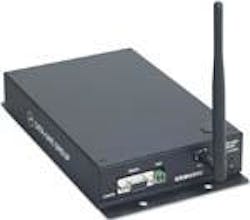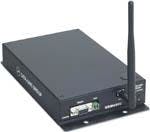Serial Modems Tie SCADA System Together
Florida's City of St. Augustine Public Works Department used an inefficient, antiquated VHF/telephone line data gathering system. Less than 15 percent of the system was functional. The city's Engineering Department, with the assistance of a local consultant, designed a state-of-the-art SCADA (Supervisory Control and Data Acquisition) system to monitor and control 12 off-site wells, 12 critical municipal lift stations, and two potable water pump stations.
In designing the project, the engineers wanted to develop a system that was reliable, easy to integrate and maintain. It also had to have an open architecture to meet the city's current requirements with the flexibility to accommodate growth.
The project began with hardware selection. Dedicated Allen-Bradley PLCs (Programmable Logic Controllers) with both analog and digital I/O were chosen for the plant and pumping stations. Data-Linc Group license-free, wireless serial modems were selected for their ease of integration, reliability and noise-rejecting spread spectrum frequency hopping technology.
The lift station RTUs were designed and constructed using wireless serial radio modems connected directly to micro PLCs via RS-232 communications ports.
DC power supplies provided the necessary power with sealed gel batteries as back up. An auctioneering-diode circuit switches from line power to battery back up instantly in the event of a power loss. Each of the RTUs monitors approximately a dozen I/O points including levels, pressures, pump failure alarms, cycle-counters, pump run status and motor elapsed time meters.
The RTUs communicate to a wireless serial modem master at the central utilities monitoring center. Here, data is polled by the PLC manufacturer's HMI software where it is displayed and stored in historical archives. The DF-1 Polling Master driver for the radio modems exists in the software package, one of several customizable drivers provided with the software. The DF-1 Polling Master driver is configured to poll data from each PLC through the remote serial radio modem according to the addresses entered in the driver's polling list. The communication speed is 19.2 K baud, maximum speed for this PLC, allowing a quick throughput time.
The well field RTUs were built with a similar design, except for the field I/O and local fiber-optic network. Here, an 18,000 foot local fiber-optic network allows three Allen-Bradley 1770 KF-3 modules to poll four PLCs each using their native RS-485 protocol. The base radio in turn polls each of the 1770 KF-3 modules and their connected PLCs by address, contained in the same polling list as the lift station RTUs. The driver can be expanded up to 256 addresses per channel.
A fiber-optic network was used to concentrate data passing to and from the PLCs and to reach to a non-wooded site, where it then communicates to the base station via radio. The well field is located roughly 10 miles from the base station in a heavily wooded area with trees reaching more than 80 feet in height. I/O data including pump status, pump failures, run timers and pressure measurement is sent back to the host HMI system. Operators at the main treatment plant can monitor and control the well pumps remotely to match incoming raw water flow with demand. In addition, operators monitor a diesel-powered generator that provides auxiliary power to the well sites in the event of a loss of power.
Prior to project implementation, daily check-ups and pump control was accomplished by a 25 minute drive to the well field every time an action had to be taken.
The pump stations are similar, although the control scheme is somewhat more complex. Each pump station uses variable speed drives to control domestic water header pressure and flow. Chemical injection to maintain high water quality is also controlled remotely by downloading dosage rates over the radio system. The RTU is centered around a compact, dedicated PLC communicating with a serial radio back to the base station radio.
Central and north central Florida are known for heavy lightning storms; however, there has not been a failure of communications due to lightning since inception of the project. In fact, the new SCADA system and its telemetry components have been in successful operation since project completion.
The project was designed for scalability and versatilityto grow as needed. St. Augustine will be adding another 10 lift station RTUs and possibly three more wells as the demand for water continues to grow.
This system is currently being integrated with a city-wide Wide Area Network that will provide monitoring and emergency override control to several different locations.
Besides its primary use for data collection and control functions, the radio-based SCADA system provides one other important feature. PLC program modifications and troubleshooting can be done right from the main workstation, over radio and without interruption of process data exchange. WW/

